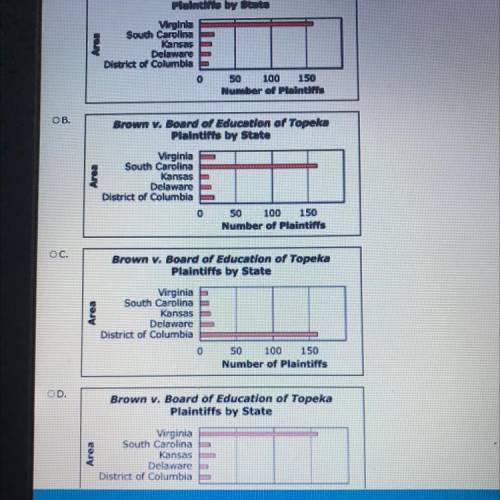
Social Studies, 13.12.2021 19:30 hadwell34
In 1952, the U. S. Supreme Court had five cases on its docket regarding school segregation. In 1954, the following cases were combined and heard before the
Supreme Court as Brown v. Board of Education of Topeka:
• Bolling v. Sharpe, with nine plaintiffs in the District of Columbia
• Belton v. Gebhart, with 12 plaintiffs in Delaware
• Brown v. Board of Education of Topeka, with 13 plaintiffs in Kansas
Briggs et al. v. Elliott, with 20 plaintiffs in South Carolina
• Davis v. County School Board of Prince Edward County, with 163 plaintiffs in Virginia
Which graph correctly expresses quantitative information from the passage?


Answers: 1


Another question on Social Studies

Social Studies, 22.06.2019 01:00
Identify how the virginia declaration of rights lead to an expansion of civil rights both in the states of virginia and, later in the entire united states
Answers: 2

Social Studies, 22.06.2019 08:00
Which statement best explains how maynard jackson's 1968 decision foretold his future? he was elected mayor of atlanta in 1973 he was elected governor of georgia in 1990. he started his own bond and security business he removed segregation signs form water fountains at city hall
Answers: 1


Social Studies, 23.06.2019 03:00
Which are components pf a political party? why do we need political parties give reason.
Answers: 2
You know the right answer?
In 1952, the U. S. Supreme Court had five cases on its docket regarding school segregation. In 1954,...
Questions



English, 12.11.2020 18:20

Mathematics, 12.11.2020 18:20



English, 12.11.2020 18:20

Mathematics, 12.11.2020 18:20

English, 12.11.2020 18:20

Mathematics, 12.11.2020 18:30

History, 12.11.2020 18:30






Health, 12.11.2020 18:30


Mathematics, 12.11.2020 18:30

Mathematics, 12.11.2020 18:30



